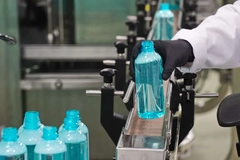Rice pump cuts carbon emissions
15 Aug 2011

A rice hull gasifier engine-pump developed by the Philippine Rice Research Institute (PhilRice) not only cuts costs in running irrigation pumps but also cuts the carbon footprint in rice fields.
A rice hull gasifier engine-pump developed by the Philippine Rice Research Institute (PhilRice) not only cuts costs in running irrigation pumps but also cuts the carbon footprint in rice fields.
PhilRice made the claim following tests on the equipment developed by Arnold S. Juliano, Joel A. Ramos, Leo B. Moliñawe, and Dr. Eulito Bautista.
The PhilRice team said the local mobile gasifier engine-pump system slashes irrigation costs by a maximum of 37 percent when using gasoline and 44 percent if it is run by diesel.
Juliano stressed that by using rice hull, farmers will spend less than a peso to generate a cubic meter of water. They have to shell out P2 for each cubic meter of water when they use gasoline.
“A 4-kilo rice hull load could run the engine for about 1-½ hours at a maintaining speed of 2000 rpm and could discharge an average of 5 liters per second from the ground water table of 2.15 meters,” Juliano said.
Field tests also showed the gasifier can endure 100-hours of cumulative use with minimal problems.
The machine, now made compact, mobile and affordable, also reduces green house gases emissions as rice hull is converted to power the machine.
Juliano said wastes produced after rice hull burning within the system can be used as soil conditioner in seedbeds, mulching material and ingredient in producing organic fertilizer.
“Components of the machines were reduced to 40 percent, which resulted in the significant reduction of weight from 500 kilos to 400 kilos, and cost, from P86,000 to P65,000.
"By continuously improving the machine, we hope that more farmer cooperatives will invest not only to save, but to help reduce the contribution of burning rice hull in global warming,” he added.
In using the machine, Juliano advised that the rice hull load should be clean and dry to produce quality gas that can run the engine with high speed and maintain good water pumping performance.
Source: Philippine Rice Research Institute
All content and features on this website are copyrighted with all rights reserved. The full details can be found in our privacy statement
Subscribe to our newsletters
By continuing to browse our site you agree to our Privacy Statement











